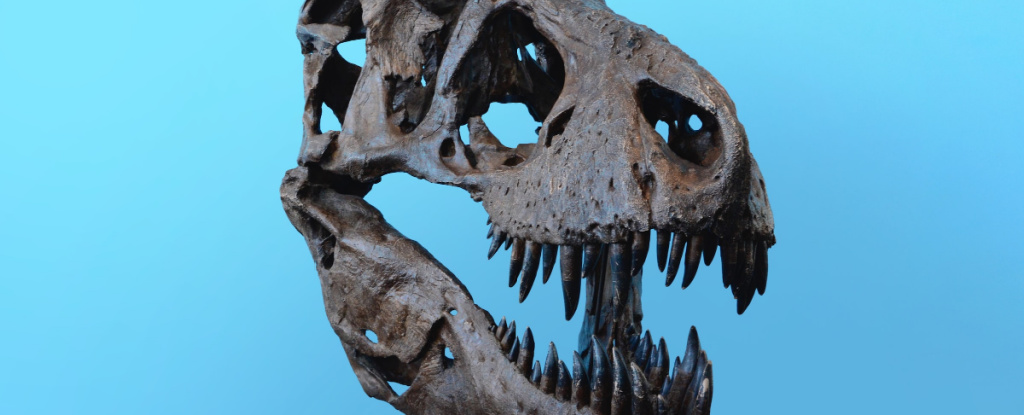A new study suggests Tyrannosaurus rex had the brains to keep up with his brawn.
According to neuroanatomist Suzana Herculano-Houzel, the Predatory dinosaurs with tiny arms often referred to as fools, might have been just as smart as modern apes — or at least had a comparable number of brain cells.
Not all paleontologists are convinced of this, however. The bold claims are “far-fetched” and based on some questionable interpretations of outdated data, they say.
But there’s nothing like a scientific controversy to ponder some big questions about intelligent beings and the electrochemical constellations in our own minds that we still don’t fully understand.
Herculano-Houzel, the sole author of the paper, used data from living birds and modern reptiles to infer how the number of neurons scales with increasing brain mass.
She then extrapolated to predict how many brain cells t rex may have had in his telencephalon – the more developed part of the brain, also commonly known as the cerebrum. This part of the neural anatomy consists of two hemispheres and is responsible (among other things) for the perception of the animal.
Herculano-Houzel appreciated that t rex had approximately 3 billion cerebral neurons packed into his 343 gram brain; more than the number found in baboons. According to their calculations, another theropod dinosaur, Aloramushas about 1 billion cerebral neurons indented in its 73 gram (2.5 ounce) brain, which is on par with that of a capuchin monkey.
If these numbers reflect wisdom, “it would make these animals not only giant, but also long-lived and endowed with flexible cognition, making them even more magnificent predators than previously thought,” said Herculano-Houzel of Vanderbilt University in Nashville, writes in their published work.
“An elephant-sized but agile biped carnivore with macaque or baboon-like perception must have been an extremely competent predator indeed,” she said adds.
It’s officially new: T. rex had a baboon-like number of brain neurons, meaning it had what it takes to build tools, solve problems, and live up to 40 years, enough to build a culture! Paper just came out in J Comp Neurol. The reality was actually scarier than the movies! pic.twitter.com/6HafJVHQlk
— Suzana Herculano-Houzel (@suzanah) January 5, 2023
That’s pretty wild to suggest Tyrannosaurus and other theropods dinosaur were “the primates of their time,” and getting there requires making some assumptions. But it’s where Herculano-Houzel is headed next that has arguably caused even more uproar among paleontologists, biologists, and neuroscientists.
Based on their findings and previous studies, Herculano-Houzel predicts t rex would have matured quickly, lived long enough – over 40 years – and had a mind capable of using tools and passing that knowledge on to relatives.
Your neurons count places Tyrannosaurus and possibly other theropod dinosaurs “in the cognitive realm of tool-using and culture-forming modern birds and primates”, Herculano-Houzel writes.
Cue a lot of skepticism. “Intelligence in itself is difficult to study, let alone the intelligence of an extinct taxon whose behavior cannot be observed,” says University of Bristol paleobiologist Tess Gallagher wrote on twitter.
“Do not get me wrong. t rex was probably smarter than we give him credit for, but tool use skills? That’s a very big claim.”
Another criticism from biologists is that skull size does not necessarily equate to brain volume or mass. Herculano-Houzel used brain size estimates based on CT scans of fossilized skulls.
During Herculano-Houzel argued Theropod brains filled their cranial cavity, other studies have suggested that the brain of t rex occupies only between a third and half of its endocranial space.
However, brain folds, folds, and synaptic connections are often thought of as such better indicators of intelligence than the overall size of the brain or even the number of cells it contains.
For example, there are crows remarkably intelligent animals with relatively small brains; They have fewer cerebral neurons than baboons but outperform them on cognitive tasks. says Kai Caspar, zoologist at the University of Duisburg-Essen in Germany.
“Maybe the number of neurons doesn’t make an animal’s mind and the connectome matters too?” Kaspar tweetedrefers to the web of connections in a particular brain.
But bony skulls endure and squishy brains don’t, so scientists really have to look past it when trying to imagine what dinosaurs looked like.
Herculano-Houzel argued that estimating the number of neurons from the brain mass is a method that has been applied to hundreds of people mammal, Birdand non-bird dinosaur species, so it’s sturdy.
But she also notes that this turns animal brains “into a homogeneous soup” of floating brain cells that are actually structured into layers of tissue.
Tyrannosaurus Continues to amaze us with recent discoveries depicting them as social animals elegant swinging cocks that tended to hunt in packsnot alone, and fought for love. No matter how many neurons their brains had, the tyrant lizards love to make us think.
The study was published in Journal of Comparative Neurology.





